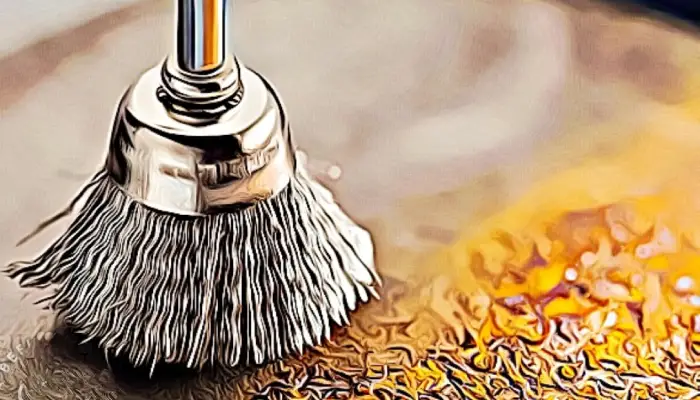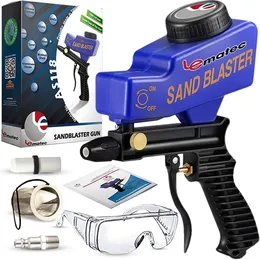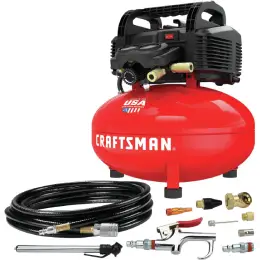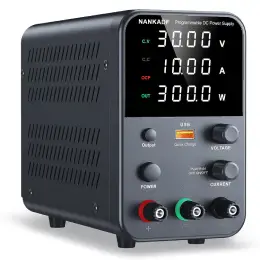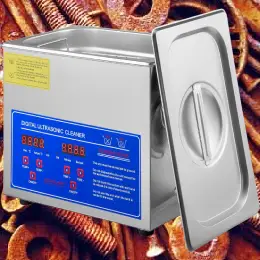Ever glanced at a once-beloved tool or a cherished piece of metal furniture, only to recoil at the unsightly rusty monsters that have taken over? Rust, that red-orange villain, might seem invincible. But today, I’m here to share the secrets, twists, and tales of how to remove rust from metal. Get ready for a journey from despair to dazzle!
Oh Rust, Why Must You Be?
But first, a surprising fact: rust is, in essence, a form of iron oxide. It forms when iron or its alloys corrode in the presence of moisture and oxygen. So, while you’ve been lamenting your rusty possessions, rust itself is nature’s peculiar artwork! But nostalgia aside, it’s got to go.
When Size Matters: How to Remove Rust from Large Metal Objects
For those who think bigger is better, rust can be a formidable foe. So, how to remove rust from large metal objects without spending eons scrubbing? Enter the sandblasting technique. It’s like giving your metal object a day at the beach, albeit a bit more aggressively. Rust doesn’t stand a chance by blasting sand particles at high velocity. But remember, this method is best left to professionals, as the powerful equipment (air compressor) and potential hazards need expertise.
Unveiling the Titan of Rust Removal: The Chemical Dipping Extravaganza!
Ever dreamt of giving an entire car a spa-like detox? Enter the world of chemical dipping immersion tanks, the grandmasters in the realm of rust-busting. These behemoth tanks, brimming with expertly concocted chemical solutions, are where cars shed their rusty pasts and emerge reborn, shining in their bare-metal glory.
It’s not just about rust removal; it’s a phoenix-like resurrection, where vintage beauties and rust-laden cruisers are submerged, only to re-emerge pristine and ready for a new lease on life. If cars could talk, they’d probably tag this experience as their ultimate spa retreat!
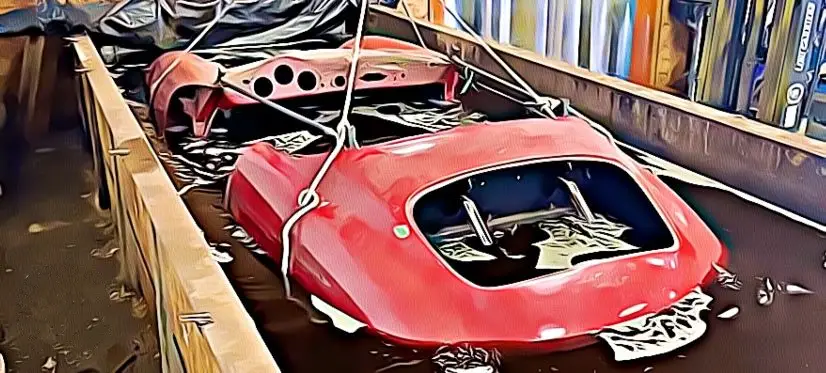
Ride Revival 101: The Ultimate Dip Tank Dive
Picture this: a classic cruiser, weighed down by years of rust and grime, prepped for the ultimate makeover session. Welcome to the glitzy world of dip tanks – where cars aren’t just cleaned; they’re reborn.
1. The Magic Potion:
We start with a cocktail – but hold the martini glasses! It’s a phosphoric acid blend, a superstar in stripping cars down to their shining souls. Throw in some high-tech degreasers and a dash of detergent, and you’ve got the spa bath of every rusted ride’s dreams.
2. The Grand Submersion:
Before our star (the car, of course) takes its deep dive, it’s dressed down to its metal-only attire. We’re talking a full-strip-down, leaving behind any plastics or fabrics. Into the tank it goes, soaking up that chemical goodness and shedding years of rust in what feels like a time warp.
3. Splash & Dash:
Once our car’s rust-melting session concludes, it’s time for the glam rinse. With high-pressure jets, every last trace of the chemical gala and the now-evicted rust and paint are blasted away, prepping the stage for the next act.
4. Neutralize & Stylize:
But wait, we’re not done! Next up, a spritz of neutralizing charm, ensuring no sneaky acid tries any after-party antics. Think of it as the aftershave to the close shave.
5. Shine Time:
Post-spritz, our car steps into the spotlight, drying out and basking in its newfound glory. But, since it’s now the most sought-after piece of metal in town, it gets a protective coat to fend off any rust groupies.
Universal Makeover Magic:
But here’s the twist: dip tanks aren’t just the go-to for cars. Oh no! From massive machinery to any oversized relic longing for a comeback, these chemical cauldrons cater to all. Whether it’s a boat anchor, a car engine, or a gigantic garden gate, the immersion rebirth is ready to roll out the red carpet for any big player in need of a makeover. Size truly doesn’t matter here; it’s all about the revival rave!
The immersion tank escapade is more than a rust-removal gig; it’s the backstage pass to every car’s dream concert—a world where cars step in weathered and walk the runway gleaming. Just remember, this gig is best left to the pros; they’re the rockstars of the Rust Revival arena!
Did You Know? Unraveling Rust’s Mysteries!
1. Nature’s Slow Burn:
Rust is metal’s version of a slow-motion fire! When iron reacts with oxygen, it’s actually oxidizing, which is like a super chill, time-lapsed combustion. So, that rusty bike in your garage? It’s been on a slow burn!
2. The Martian Connection:
Ever wonder why Mars is nicknamed the ‘Red Planet’? That signature reddish hue is thanks to vast amounts of iron oxide on its surface. Yep, Mars is basically showing off its rusted beauty!
3. Titanic’s Disappearing Act:
The iconic ship, Titanic, lying deep in the ocean, isn’t just rusting away. It’s being consumed by a rust-eating bacteria called ‘Halomonas titanicae’. Nature’s cleanup crew is literally dining out on history!
4. Rust as Art:
Some artists intentionally use rust patterns in their work. By controlling the oxidization process, they create unique, organic designs. Rust isn’t always the enemy; sometimes, it’s the muse.
5. Sound of Rust:
Okay, not really, but rust can influence sound! Rusty strings on musical instruments or a rusted tuning fork can produce distorted tones. So, that old, rusty guitar might have its own unique tune.
Unearthing these quirks about rust isn’t just about fun facts. It’s about appreciating the beauty, science, and sometimes the musical notes in the unexpected corners of our world. 🌍🎸🚀
Sanding Saga: The Rockstar Rhythm of Rust Redemption
Step aside, modern gizmos and gadgets! Enter Sanding: the age-old, bicep-building technique of rust warfare. It’s not just about elbow grease; it’s a rhythmic dance of metal and grit, where each swipe uncovers a layer of the past, restoring shine and stories. It’s raw, it’s real, and it’s rugged. In the battle against rust, Sanding is like the rockstar that needs no autotune. Authentic, gritty, and always in style.
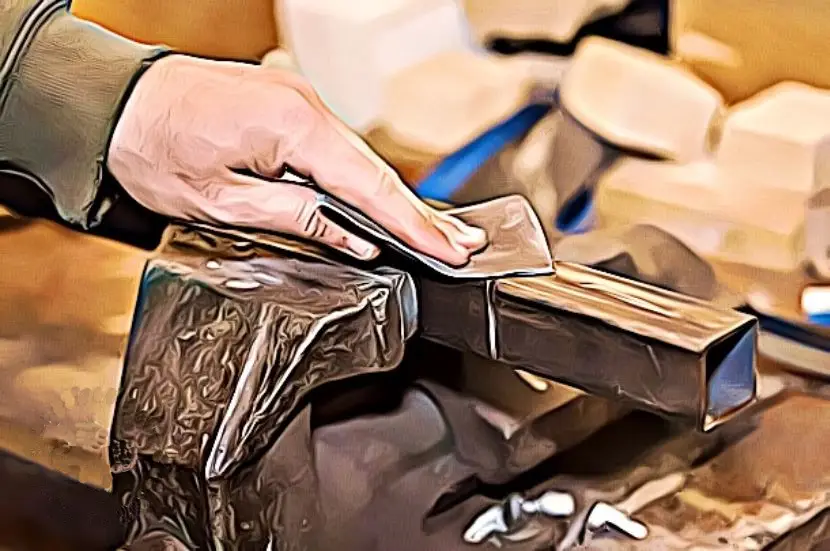
Brushing Up with Bravado
Think of the wire brush as your trusty sidekick in the battle against rust. With a sturdy grip and some elbow grease, this simple tool gets the job done. Scrub away the old, flaky rust and reveal the clean metal hiding beneath. No fuss, no fancy gear, just effective results. It’s the classic go-to that never lets you down.
Mother Nature’s Elixirs: How to Remove Rust from Metal at Home
Would you believe me if I said your kitchen might hold the key to your rust problems? It’s true! When pondering how to remove rust from metal at home, the solution can be as simple as white vinegar. Its acidity breaks down rust, making it easier to scrub away. Just soak the rusty object in white vinegar for a few hours, then scrub. Voilà!
Let’s twist things up for those not fond of the vinegar smell. Did you know potatoes and baking soda can be rust-busting buddies? Cut a potato in half, sprinkle baking soda on the cut side, and rub it over the rusted area. The oxalic acid in potatoes acts against rust.
A perplexing twist? Did you know cola drinks can combat rust? Due to their phosphoric acid content, they can help dissolve rust. Just soak the rusted part in cola, wait, and then scrub. As for the leftover cola? Maybe enjoy it with some chips while you admire your rust-free metal.
Beyond the Baking: Baking Soda’s Rust-Busting Chronicles!
Alright, let’s take a quick detour to the superstar of the pantry: Baking Soda. This powdery white wonder isn’t just for pancakes and cookies. Nope, it’s got a secret double life. Think of it as the undercover agent of rust removal. Sprinkle some on a rusty spot, add a dash of water to create a paste, scrub, and watch as it waves its magic wand over tarnished treasures. Baking soda is like the cool, unassuming friend who always saves the day at the last minute. Rust? Not on baking soda’s watch!
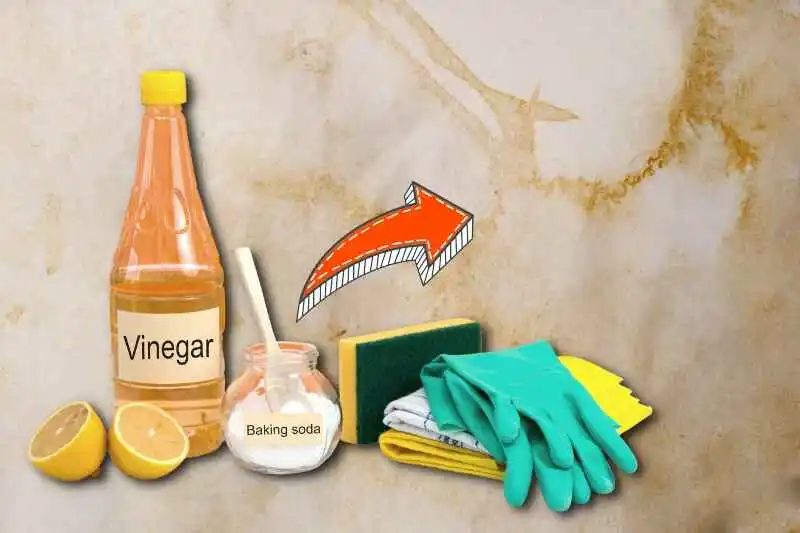
Alchemy of Rust Removal: Culinary-Inspired Concoctions for Metal Makeovers
1. “Rusty’s Remorse” – The Classic Vinegar and Salt Solution
Ingredients:
- 2 cups white vinegar
- 1/4 cup table salt
- One rusted object 🌟🔧🔥
Method:
- In a bowl, dissolve the salt in the vinegar.
- Soak the rusted object for 1-3 hours, depending on the severity of the rust.
- Remove and scrub with a brush.
- Rinse and pat dry.
2. “Tinman’s Tonic” – Baking Soda Paste
Ingredients:
- Baking soda (amount depends on the size of the rusted area)
- Water
Method:
- Mix baking soda with water to form a thick paste.
- Slather generously onto the rusted area.
- Let sit for a couple of hours.
- Scrub off with a brush, rinse, and pat dry.
3. “Citrus Surge” – The Zesty Lemon-Salt Combo
Ingredients:
- One fresh lemon (or lime)
- Coarse salt
Method:
- Sprinkle a generous amount of salt over the rusted area.
- Squeeze lemon juice over the salt until it’s soaking.
- Let this sit for 2-3 hours. The salt provides an abrasive texture, while the acid in the lemon attacks the rust.
- Scrub off with the used lemon half or a brush. Rinse thoroughly.
Bonus Recipe: “Potato Power Punch”
Ingredients:
- One raw potato, cut in half
- Dish soap or baking soda
Method:
- Dip the cut side of the potato in the dish soap or baking soda.
- Rub the potato over the rusted area. The oxalic acid in the potato helps break down the rust.
- Rinse and repeat if necessary.
Remember, for all methods, it’s essential to dry the metal thoroughly after treatment to prevent future rusting. Happy rust-busting!
Quick Fixes: Quickest Way to Remove Rust from Metal
In a hurry? Need results pronto? Commercial rust removers are your speedy solution when considering the quickest way to remove rust from metal. These concoctions, available at most hardware stores, contain potent chemicals that dissolve rust. But a word of caution: always use gloves and work in well-ventilated areas. Safety first!
What DOES Remove Rust from Metal? Tools and Tricks of the Trade
1. Electrolysis for Dummies (and the Occasionally Clumsy)
A realm where science, sorcery, and a smidgen of madness entwine. Picture this: your rusted relic, submerged in a water-baking soda cocktail, hooked up to a variable power supply – think of it as cardio for corroded cutlery.
With a flip of a switch, electrical currents transform that rust into easily brushable black iron oxide. It’s a blend of spa day indulgence and electrifying genius. If our ancestors peeked in, they’d dub us wizards of the wire. But remember, there’s a thin line between looking like a genius and getting zapped; expertise is essential!
2. Ultrasonic Unleashed: Rust’s High-Tech Nemesis!
Ultrasonic cleaning is like giving your rusty items a bubble bath. Soundwaves create tiny bubbles that pop and scrub away dirt and rust. For the best results, you need more than just water – a special cleaning solution does the trick. It works best on light rust; for the tough stuff, you might need something extra. Remember to rinse and dry your items after and choose your cleaning solution carefully. In the battle against rust, ultrasonic cleaning is a handy sidekick!
3. Laser Love for Rusty Relics
Step aside traditional methods and make way for the laser show! Laser rust removal is the future’s answer to pesky corrosion. With precision and flair, it zaps away the old and rusty, revealing gleaming metal beneath. It’s not sci-fi—it’s just cutting-edge rust busting, where lasers shine and rust simply fades away in the spotlight. Beam on! 🌟🔧🔥
Can You Really Remove All Rust from Metal?
“Can you remove rust from metal entirely?” A question I often get. With persistence and the proper techniques, absolutely! Yet, here’s where expertise matters. Always choose the method suitable for the metal type and rust extent. For instance, finer metals like copper jewelry might not appreciate the abrasiveness of sandpaper. Gentle methods, like lemon and salt, might be more fitting.
Rust Busting with Style and Sense
Tackling rust is a mix of art and science, but let’s not forget the golden rule: Safety with swagger! Before diving into the nitty-gritty of rust removal, arm yourself with these savvy safety tips. It’s not just about making your metals shine; it’s about keeping you in top form while you do it. Here’s how to conquer rust while staying cool and, most importantly, safe:
1. Gear Up:
Always wear protective gloves, preferably nitrile or latex, when handling chemicals or rusty metal to avoid skin irritation or cuts.
2. Eyes on the Prize:
Safety goggles are a must. When scrubbing rust or using chemical solutions, there’s always a chance of splashing.
3. Breathe Easy:
If you’re using strong chemicals, especially indoors, ensure good ventilation. Consider wearing a mask or respirator for added protection.
4. Child and Pet Alert:
Ensure kids and pets are away from the rust removal area. Store all chemicals out of their reach.
5. Read and Heed:
If using commercial rust removers, always read the label. Follow the manufacturer’s instructions to the letter.
6. Neutralize and Dispose:
Done with the chemicals? Don’t just pour them down the drain! Neutralize them as recommended and dispose of them following local regulations.
7. Stay Grounded:
If using electrical methods like electrolysis, ensure all connections are safe and always disconnect power before making adjustments.
8. First Aid Familiarity:
Know the basics! Have a first aid kit handy, and be aware of what to do in case of skin or eye contact with chemicals.
9. Tetanus Alert:
Rust doesn’t cause tetanus, but sharp metal objects can be a breeding ground for the bacteria Clostridium tetani, which does. If you get a deep cut or scratch, especially from rusty metal, cleaning the wound thoroughly and seeking medical advice is essential. Ensure your tetanus shots are up-to-date when frequently handling rusty objects.
Rust removal is rewarding, but your safety always comes first. Equip yourself with knowledge and protective gear, and you’re on your way to a successful, injury-free project.
A Rust-Free Future: Prevention Is Key
Now that we’ve unlocked the secrets of how to remove rust from metal let’s step into the future. Because prevention, my friends, is where the real magic lies. Keeping your metals dry, using protective coatings, and regular maintenance checks are the secrets of a rust-free world.
Rust’s Kryptonite – The Rust Inhibitor:
After tackling the rust, you’re not quite done! Picture the rust inhibitor as your metal’s protective superhero cape. Slap it on, and it forms an invisible shield, ensuring rust doesn’t make an unwelcome comeback. It’s not just about a temporary fix; it’s about gifting your metal a longer, rust-free life. It’s the encore performance after the main show, making sure your metal remains the star, year after year.
FAQ: The Rust-Busting Edition 🌟
Laser rust removal! It’s like giving your metal a futuristic spa treatment.
If only! Rust is like that unwelcome party guest; if not shown the door, it’ll stick around and invite more friends.
Well, while rust is metal’s way of showing age and wear, it’s also a testament to time, nature, and the elements. So yeah, it’s kinda deep!
Almost! It’s a method that uses electric currents to banish rust. Less secret society and more science awesomeness.
Both have their moments to shine. Wire brushes are your go-to for a quick scrape, while chemicals play the long game. Pick your player!
Absolutely! Keeping safe is our number one jam, but doing it with swagger? Now, that’s the full package.
Fear not! With the right tools and techniques (and maybe a sprinkle of determination), your garden buddy can be restored to its former glory. Challenge accepted!
In Conclusion: The Rusty Requiem
From the depths of despair, rusted objects can indeed be reborn, gleaming and shining. And as we’ve journeyed today, the paths to rediscover their glory are many. Whether it’s the humble potato, the might of electrolysis, or just some good old elbow grease, rust is not the end of the story.
In our quest for answers on how to remove rust from metal, we’ve not only uncovered methods but also embraced the delightful twists of nature and science. So, the next time you see a rusted object, see it not as a lost cause but as a potential masterpiece waiting to be restored. Shine on!
Now that you’re clued up on busting rust from my comprehensive guide on how to remove rust from metal, why not widen your home improvement horizons? Dive into more budget-friendly home repair tips and tricks you might’ve overlooked. From DIY shortcuts to savvy solutions, check out these essential repair gems
